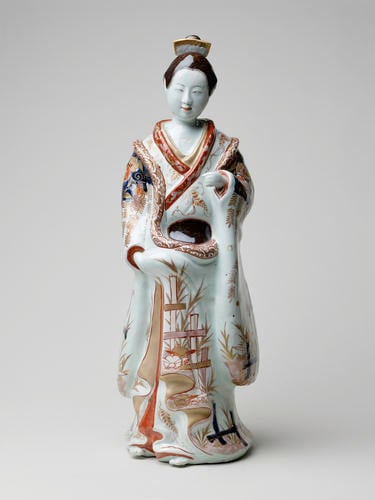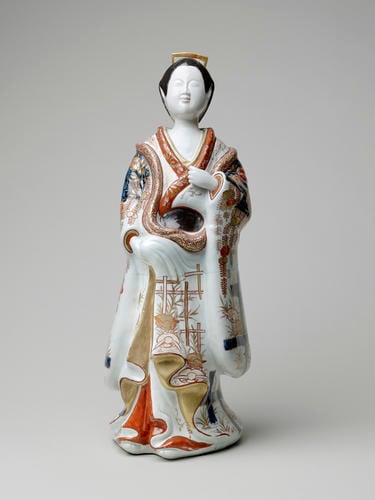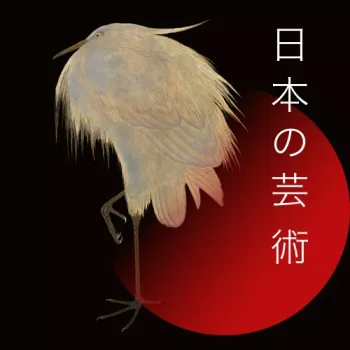Two female figures c.1690-1730
Porcelain painted in underglaze blue, overglaze enamels and gold | 58.0 x 23.0 x 18.0 cm (whole object) | RCIN 2402
-
Figures of bijin (beautiful women) were a popular theme in woodblock prints of the ukiyo-e genre, which depicted fashionable ladies of the urban pleasure quarters. The forms were translated onto porcelain for the European market, where the combination of eye-catching kimono and demure posture created an idealised view of the exotic, amenable Japanese woman. These figures’ bright outer robes (uchikake) are decorated with hares, wisteria and plum, evoking the garments worn by wealthy courtesans of the Edo period (1615–1868). Models for making free-standing figures like these have been recovered at the enamellers’ quarter, Aka-e-machi, in Arita. Such items were shipped to Europe in vast quantities during the years of Japan’s porcelain export trade, often packed within lacquer cabinets to save space.
George IV evidently took an interest in depictions of people from Japan and China, and in their clothes and accessories. At the Royal Pavilion, Brighton, he displayed an extraordinary series of lifelike Chinese clay figures dressed in the garments of the Qing dynasty, whose heads nodded with the aid of a pivoting rod, while these Japanese figures were housed in English marble-and-ormolu covered settings in the Saloon. The Saloon furnishings were later re-used in the Yellow Drawing Room at Buckingham Palace, where male Chinese figures were also displayed in the niches of the marble-and-ormolu chimneypiece (rcin 9400.a–c).
Pair of figures of Japanese ladies. Standing with feet protruding from ample, long-sleeved robes. Her left hand is held at her breast, cupped as if holding some attribute; her right hand grasps her robe, which falls in folds to the ground. On the face, the features are pencilled in, and the hair swept back in a lustrous, black, bunched chignon. The robe, with red and gilt borders, is tied in front with a black obi sash, and patterned at the sides and back with wisteria and fencing in blue, and with hares among leaves, with a lustrous purple wash at the foot. In irregularly shaped panels on the shoulders are prunus blooms on a blue and gold ground.
Text adapted from Chinese and Japanese Works of Art in the Collection of Her Majesty The Queen: Volume II and Japan: Courts and Culture (2020)Provenance
Almost certainly acquired by George IV. Inventoried at the Royal Pavilion, Brighton, as ‘Two Japan Female Figures, white ground, blue, red and gold flowers &c, on pierced mahogany square pedestals, two feet five inches [73.7 cm]’ (1829B, p. 115); sent in March 1847 to Buckingham Palace (1829A, p. 12), they were in the Yellow Drawing Room there in 1921 (1829B, p. 115).
-
Creator(s)
(nationality)Acquirer(s)
-
Medium and techniques
Porcelain painted in underglaze blue, overglaze enamels and gold
Measurements
58.0 x 23.0 x 18.0 cm (whole object)
55.5 x 19.0 x 17.5 cm (whole object)
Other number(s)
Place of Production
Arita [Saga, Japan]











